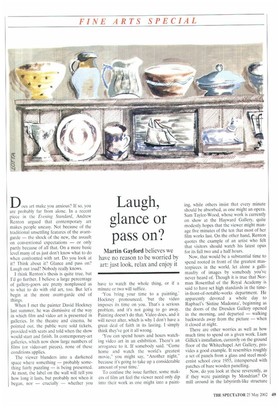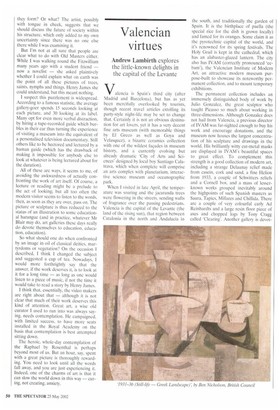Laugh, glance or pass on?
Martin Gayford believes we have no reason to be worried by art: just look, relax and enjoy it
Does art make you anxious? If so, you are probably far from alone. In a recent piece in the Evening Standard, Andrew Renton argued that contemporary art makes people uneasy. Not because of the traditional unsettling features of the avantgarde — the shock of the new, the assault on conventional expectations — or only partly because of all that. On a more basic level many of us just don't know what to do when confronted with art. Do you look at it? Think about it? Glance and pass on? Laugh out loud? Nobody really knows.
I think Renton's thesis is quite true, but I'd go further. I believe a large percentage of gallery-goers are pretty nonplussed as to what to do with old art, too. But let's begin at the more avant-garde end of things.
When I met the painter David Hockney last summer, he was dismissive of the way in which film and video art is presented in galleries. In the theatre and cinema, he pointed out, the public were sold tickets, provided with seats and told when the show would start and finish. In contemporary-art galleries, which now show large numbers of films (or video-art pieces), none of these conditions applies.
The viewer blunders into a darkened space where something — probably something fairly puzzling — is being presented. At most, the label on the wall will tell you how long it lasts, but probably not when it began, nor — crucially — whether you have to watch the whole thing, or if a minute or two will suffice.
'You bring your time to a painting,' Hockney pronounced, tut the video imposes its time on you. That's a serious problem, and it's not going to go away. Painting doesn't do that. Video does, and it will never alter, which is why I don't have a great deal of faith in its lasting. I simply think they've got it all wrong.
'You can spend hours and hours watching video art in an exhibition. There's an arrogance to it. If somebody said. "Come home and watch the world's greatest movie," you might say, "Another night," because it's going to take up a considerable amount of your time.'
To confuse the issue further, some makers of film art feel the viewer need only dip into their work as one might into a paint
ing, while others insist that every minute should be absorbed, as one might an opera. Sam Taylor-Wood, whose work is currently on show at the Hayward Gallery, quite modestly hopes that the viewer might manage five minutes of the ten that most of her film works last. On the other hand, Renton quotes the example of an artist who felt that visitors should watch his latest opus for its full two and a half hours.
Now, that would be a substantial time to spend rooted in front of the greatest masterpieces in the world, let alone a gallimaufry of images by somebody you've never heard of. Though it is true that Norman Rosenthal of the Royal Academy is said to have set high standards in the timein-front-of-notable-works department. He apparently devoted a whole day to Raphael's 'Sistine Madonna', beginning as the doors of the Dresden Gallery opened in the morning, and departed — walking backwards away from the picture — when it closed at night.
There are other worries as well as how much time to spend on a given work. Liam Gillick's installation, currently on the ground floor of the Whitechapel Art Gallery, provides a good example. It resembles roughly a set of panels from a glass and steel modernist school circa 1955, interspersed with patches of bare wooden panelling.
Now, do you look at these reverently, as if they were paintings by Mondrian? Or mill around in the labyrinth-like structure they form? Or what? The artist, possibly with tongue in cheek, suggests that we should discuss the future of society within his structure, which only added to my own uncertainty since there was no one else there while I was examining it.
But I'm not at all sure that people are clear what to do with Old Masters either. While I was walking round the Fitzwilliam many years ago with a student friend — now a novelist — she asked plaintively whether I could explain what on earth was the point of all these pictures of trees, saints, nymphs and things. Henry James she could understand, but this meant nothing.
I suspect this puzzlement is widespread. According to a famous statistic, the average gallery-goer spends 15 seconds looking at each picture, and 30 looking at its label. Many opt for even more verbal distraction, by hiring a tape-recorded guide which burbles in their ear thus turning the experience of visiting a museum into the equivalent of a personalised television documentary. Still others like to be hectored and lectured by a human guide (which has the drawback of making it impossible for anybody else to look at whatever is being lectured about for the duration).
All of these are ways, it seems to me, of avoiding the awkwardness of actually confronting the work of art itself. Of course, a lecture or reading might be a prelude to the act of looking; but all too often the modern visitor seems to listen to the words, then, as soon as they are over, pass on. The picture or sculpture is thus reduced to the status of an illustration to some educational harangue (and in practice, whatever Mr Blair may do, art galleries these days really do devote themselves to education, education, education).
So what should one do when confronted by an image in oil of classical deities, martyrdoms or vegetation? On the occasion I described, I think I changed the subject and suggested a cup of tea. Nowadays. I would more forthrightly say that the answer, if the work deserves it, is to look at it for a long time — as long as one would listen to a piece of music, if not the time it would take to read a story by Henry James.
I think that, essentially, the video makers are right about that — although it is not clear that much of their work deserves this kind of attention. Great art, a wise old curator I used to run into was always saying, needs contemplation. He campaigned, with limited success, to have more seats installed in the Royal Academy on the basis that contemplation is best attempted sitting down.
The heroic, whole-day contemplation of the Raphael by Rosenthal is perhaps beyond most of us. But an hour, say, spent with a great picture is thoroughly rewarding. You need to look until all the words fall away, and you are just experiencing it. Indeed, one of the charms of art is that it can slow the world down in this way — curing, not creating, anxiety.























































































 Previous page
Previous page